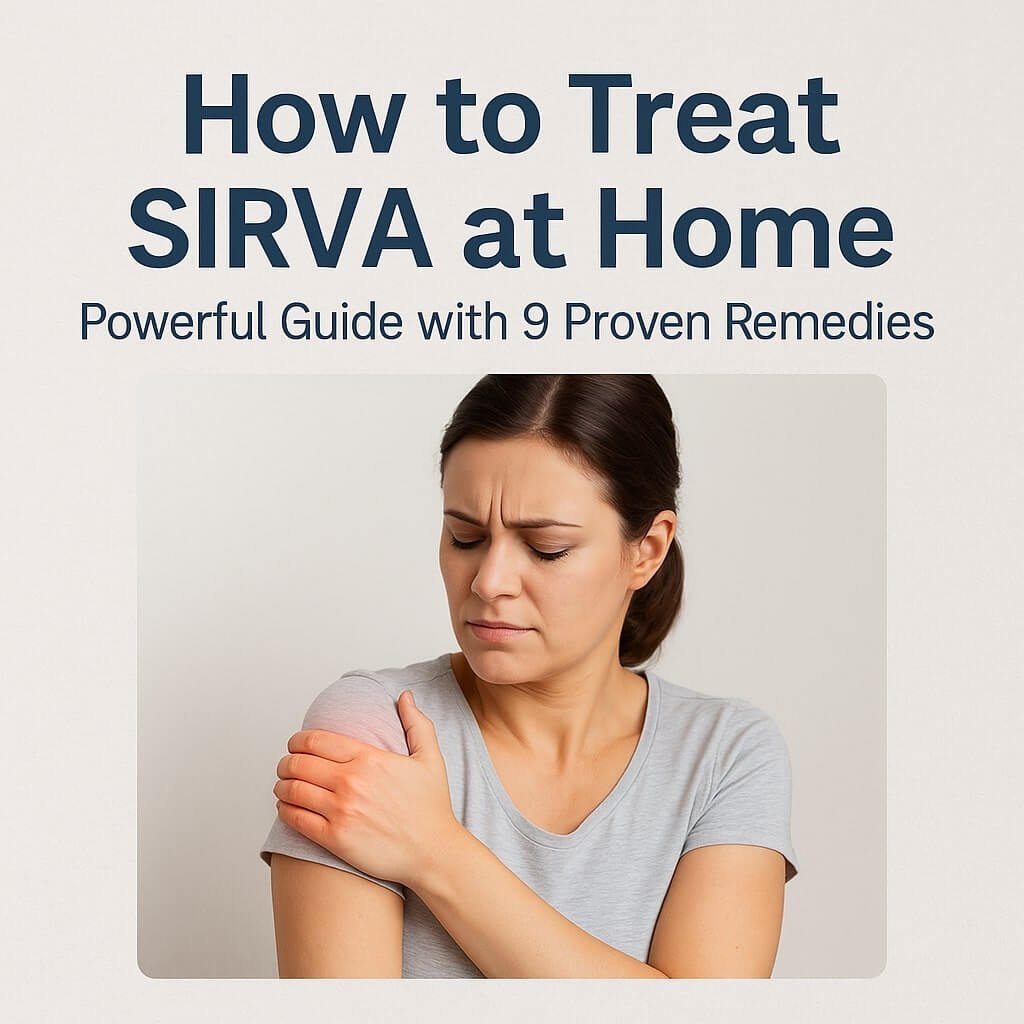Shoulder Injury Related to Vaccine Administration (SIRVA) is an uncommon but potentially painful condition caused when a vaccine is improperly injected too high or deep into the shoulder. This results in inflammation of the shoulder’s bursa, tendons, or ligaments.
SIRVA isn’t just mild soreness. It’s a more persistent and often debilitating issue that can interfere with daily tasks, sleep, and mobility.
Key Facts:
- SIRVA is not an infection, but a mechanical injury.
- It usually presents within 48 hours after a vaccination.
- Often mistaken for normal post-vaccine soreness, SIRVA doesn’t resolve quickly.
Common Causes of SIRVA
Understanding the cause is the first step toward effective home treatment.
| Cause | Description |
|---|---|
| Improper Injection Site | The vaccine was administered too high on the arm |
| Incorrect Needle Angle | The vaccine was administered too high on the arm |
| Repeated Vaccination in Same Area | Can cause cumulative trauma |
| Poor Injection Technique | Repeated Vaccination in the Same Area |
Early Signs and Symptoms of SIRVA
It’s crucial to differentiate between standard injection soreness and SIRVA. Here are the telltale signs:
- Persistent, sharp pain in the upper arm or shoulder
- Swelling or warmth near the injection site
- Limited range of motion
- Pain that disrupts sleep
- Symptoms not improving after 72 hours
If these symptoms sound familiar, you might be dealing with SIRVA.
Can SIRVA Heal on Its Own?
Yes and no.
Mild cases can resolve with home care in a few weeks. However, severe inflammation or untreated SIRVA can lead to long-term complications like adhesive capsulitis (frozen shoulder).
The goal of home treatment is to:
- Reduce inflammation
- Restore mobility
- Prevent chronic damage
Let’s explore the most effective home remedies next.
Diagnosing SIRVA at Home
While a definitive diagnosis requires imaging (like an MRI), you can reasonably suspect SIRVA based on:
- Timing – Symptoms appear within 48 hours post-vaccine.
- Pain Location – Deep shoulder pain is not limited to the surface.
- Reduced Mobility – Trouble lifting the arm or rotating it.
Still unsure? Keep a daily symptom log. If pain worsens or persists, seek medical advice.
Home Remedies to Treat SIRVA
These remedies are designed to relieve pain, reduce inflammation, and improve shoulder function.
1. Ice Therapy
When to use: First 48 hours
Apply a cold pack to the affected shoulder for 15-20 minutes every few hours. Ice reduces inflammation and numbs the area, offering immediate relief.
2. Gentle Stretching Exercises
Start slow. Begin with pendulum swings, wall crawls, and shoulder circles. These promote blood flow and help retain mobility.
Tip: Never push through sharp pain.
3. Anti-Inflammatory Diet
What you eat can support healing.
- Increase: Leafy greens, berries, turmeric, ginger, omega-3s
- Avoid: Sugary snacks, processed foods, alcohol
This helps reduce internal inflammation.
4. Over-the-Counter Pain Relievers
NSAIDs like ibuprofen or naproxen can alleviate pain and inflammation. Always follow dosage instructions and consult a pharmacist if you’re on other medications.
5. Heat Therapy After 48 Hours
Once swelling subsides, apply heat packs. This relaxes muscles and increases circulation, aiding in recovery.
Caution: Don’t use heat in the first 48 hours—it can worsen swelling.
6. Essential Oils for Shoulder Pain
- Lavender: Soothing and calming
- Peppermint: Cooling sensation
- Eucalyptus: Anti-inflammatory
Dilute with carrier oil and apply gently to the shoulder.
7. Massage Therapy
You can self-massage or enlist help. Focus on the surrounding muscles to release tension. Avoid deep pressure directly over the injection site.
8. Posture Correction
Slouching strains the shoulder. Sit upright, roll your shoulders back, and consider ergonomic chairs or cushions for support.
9. Rest and Shoulder Support
Avoid heavy lifting or overhead movements. Use a sling briefly if necessary, but don’t immobilise too long—it may stiffen the joint.
How Long Does Recovery Take?
Most mild to moderate SIRVA cases improve within 4–6 weeks using home treatments.
Factors affecting recovery:
- Severity of injury
- Early intervention
- Consistency with home care
If improvement isn’t noticeable after 2 weeks, professional help may be needed.
When to See a Doctor
Don’t ignore these red flags:
- Pain that worsens despite home care
- Inability to raise your arm past shoulder height
- Numbness or tingling
- Fever or redness (possible infection)
A physical therapist or orthopedic doctor may recommend:
- Cortisone injections
- Physical therapy
- Imaging scans
- In rare cases, surgery
Tips to Prevent SIRVA in the Future
Prevention is better than a cure. Here’s how:
| Tip | Why It Helps |
|---|---|
| Keeps shot in the muscle, not joint | Keeps shot in the muscle, not the joint |
| Relax your arm | Reduces muscle tension |
| Choose experienced healthcare providers | Proper technique matters |
| Avoid vaccines too high on the shoulder | Prevents bursa injuries |
Share this knowledge with others—it could save someone from unnecessary pain.
Frequently Asked Questions (FAQs)
Can I still exercise with SIRVA?
Is SIRVA permanent?
Can I get SIRVA from a flu shot?
How do I know if it’s SIRVA or a rotator cuff injury?
Should I stop getting vaccinated?
Is heat or ice better for SIRVA?
Conclusion
SIRVA can be painful and frustrating, but it’s treatable—especially if caught early. By following these home remedies and being proactive about shoulder health, you can heal naturally and regain your range of motion.
Remember, if symptoms persist or worsen, don’t hesitate to consult a healthcare professional. The earlier you act, the better your chances for a full recovery.













